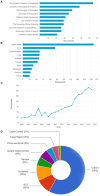Pediatric Sepsis Research: Where Are We and Where Are We Going?
- PMID: 35223703
- PMCID: PMC8873512
- DOI: 10.3389/fped.2022.829119
Pediatric Sepsis Research: Where Are We and Where Are We Going?
Abstract
Sepsis continues to be one of the leading causes of admission to the Pediatric Intensive Care Unit, representing a great challenge for researchers and healthcare staff. This mini review aims to assess research on pediatric sepsis over the years. Of the 2,698 articles retrieved from the Scopus database, the 100 most cited were selected (50 published since 2000 and 50 published since 2016). The most cited studies, published in the 21st century, are highlighted, with their main findings and perspectives.
Keywords: bibliometrics; pediatric intensive care; pediatrics; sepsis; septic shock.
Copyright © 2022 Massaud-Ribeiro, Silami, Lima-Setta and Prata-Barbosa.
Conflict of interest statement
The authors declare that the research was conducted in the absence of any commercial or financial relationships that could be construed as a potential conflict of interest.
Figures

References
-
- de Souza DC, Gonçalves Martin J, Soares Lanziotti V, de Oliveira CF, Tonial C, de Carvalho WB, et al. . The epidemiology of sepsis in paediatric intensive care units in Brazil (the Sepsis PREvalence assessment database in pediatric population, SPREAD PED): an observational study. Lancet Child Adolesc Heal. (2021) 5:873–81. 10.1016/S2352-4642(21)00286-8 - DOI - PubMed
-
- Boeddha NP, Schlapbach LJ, Driessen GJ, Herberg JA, Rivero-Calle I, Cebey-López M, et al. . Mortality and morbidity in community-acquired sepsis in European pediatric intensive care units: a prospective cohort study from the European childhood life-threatening infectious disease study (EUCLIDS). Crit Care. (2018) 22:143. 10.1186/s13054-018-2052-7 - DOI - PMC - PubMed
Publication types
LinkOut - more resources
Full Text Sources

